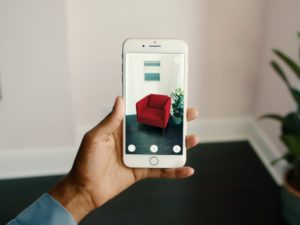Part two of a five-part series on how augmented reality is changing every industry
The way you shop has been the same for decades.
You go to the store, find some clothes you like, maybe try it on, and then check out with the apparel.
Only as of recently have you been able to purchase items online. And even then, there are still faults that leave you with wanting to ship back the products.
Augmented reality (AR) is improving the entire process.
Shopping Retail

Retail shopping has never been easier.
In the past, you had to either get your measurements or guess your clothing size before you buy. This leads to a high return rate because clothing sizes vary per manufacturer.
Clothing also looks different on every body type, so even if it looks good on the image of the model, there was no way to tell if it would look good on your body type as well.
Now, brands like American Apparel, Gap, and Lacoste use augmented reality within their apps to measure your body and let you know your estimated clothing size.
The apps allow you to see what the product would look like on your body before you buy it. Now, the customer is able to make a better-informed decision on what they’re about to buy. This leads to less returns overall.
Let’s take a look at Lacoste.
To measure your shoe size all you have to do is place your foot by their sticker, point the camera at your foot, and then the app will scan your foot and tell you your size, as well as showing you different styles that you might like.
Helpful tools like this are soon going to be available through most retail apps.
Other characteristics the apps include are letting the customer see similar styles to the one they’re viewing and they’re also able to see reviews of the item they chose.
This way, customers are able to get the full shopping experience while also knowing all the information about the product.
Facial Recognition
![]()
Accurate facial recognition is one of the key elements in making AR work well in retail.
Because AR can track your face, you can try on hundreds of glasses without having to spend hours at a store.
Companies like Frames Direct and Warby Parker make this a reality.
You can use their apps to see the glasses on your face, tell the company your prescription, and get your favorite glasses shipped straight to your doorstep. This can all be done without leaving your home which truly takes shopping to the next level.
Facial recognition isn’t only useful for shopping for glasses.
Facial tracking also lets you view what makeup products look like on your face without you having to wear any of it.
Popular cosmetic companies like Sephora already have this feature and are continually making improvements to the app.
Other facial recognition technologies include AR makeup mirrors.
A popular cosmetic brand, MAC, has introduced a mirror that lets you try on different makeup shades, without having to use any product.
While also helping with cosmetics, AR can also help by saving in-store costs.
Because the virtual assistant can tell you what items they have in stock and all other information about the product, there is less of a need for clerks. There will still be people working in stores, but when AR takes off, there will be less of a need to have in-store clerks.
Retailers can also save money on product sampling.
Because cosmetics companies have magic mirrors that allow you to test makeup virtually, less real-life sampling will be used, saving the companies lots in the long run.
Grocery Shopping

Now, you can buy all your groceries online and have them shipped right to your door with companies like Amazon. But if you like to physically go grocery shopping, new apps have come out that are helpful in any grocery store.
The Swiss company, Scandit, created an app that not only gives you general product information but also warns you about allergens in the product you’re scanning.
So instead of taking the risk with new products, you’re warned ahead of time and can skip the gluten.
While helping steer clear of food allergies, AR can also help in navigating the customer towards products they are looking for.
With AR navigation, you don’t have to rely on your map reading skills to find products. Instead, arrows point through your camera to show you where you need to turn. This way even a four-year-old can find the most hidden product.
This technology also offers you the best coupons and gives you a mobile-pay option which is the most crucial element to skipping the worst part of shopping:
The long lines!
Home Improvement

Decorating your home can be a lot of fun. From picking out colors to finding the perfect piece of furniture, good interior design is essential in creating your perfect space.
But what happens when you think you’ve found the couch of your dreams and then once you haul it back to your place, the couch doesn’t fit.
You have to lug it all the way back to the store and start their return process.
Skip the returns with these AR-integrated home improvement apps:
Ikea and Target have unveiled apps that allow the user to test different furniture throughout their space.

Along with furniture, AR also lets you test paint colors throughout your home.
Home depot has introduced a feature that allows the user to change their wall colors to their available paint. That way you don’t have to swatch your own walls and you don’t have to waste time running back to the store if your colors don’t work out.
Is AR for Shopaholics?
The way we shop is changing as we know it. With augmented reality, the industry is becoming more consumer-friendly by bettering the shopping experience in every way.
From protecting you from the food you’re allergic to, from being able to order your size on the first try, AR inclusion is a no-brainer in shopping.
Like this article? Check out others in this series or check out Fyresite for more.
 Lauren Lively
Lauren Lively 





